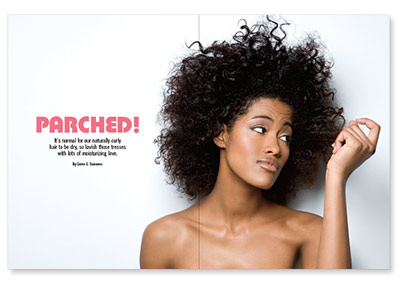
For those who don’t know, African-American hair can be decidedly dehydrated. That’s just how it grows out of our heads. When hair strands are straight, it’s easy for the natural oils to travel down the hair shaft and keep coils moisturized. But with curly hair, it’s a lot harder for the oils to navigate the length of our strands, and that causes the hair to get brittle, especially near the ends.
While this tendency toward dryness doesn’t necessarily indicate unhealthy hair or even improper hair maintenance, it does mean that extra measures must be taken to keep the hair hydrated.
If there is any one hair rule to follow, this is it: Make sure you take care of the scalp and new growth. “The hair bulb and follicle are below the scalp’s surface; therefore, the scalp should be lubricated, massaged and cleansed regularly to ensure the hair growing underneath comes through strong and healthy,” says Toni Love, a hair loss specialist. “New growth is our indicator that the hair is growing and emerging in its healthiest state.”
“With thicker, coarser hair types, it’s more likely that the scalp may not produce enough oil,” says Athena Solomon, owner of A Beautiful Day Salon in Southfield, Michigan. And the lack of oil on the scalp can also cause the skin to tighten, says Love, “so hair will appear dry and brittle.”
In addition, Solomon adds, “the middle and ends of hair will not benefit from that natural oil because it tends to settle on the scalp.”
That’s one of the reasons hair ends need extra moisturizing and conditioning—because the natural oils of the scalp aren’t distributed to the tips. Another reason? “The distribution of oils and conditioners is important to hair ends because of the usage of heated tools, such as flatirons, hot rollers and blow-dryers,” Love says. “Some consumers use flatirons and curlers every day, mostly on the ends of the hair. Therefore, [this section] needs to be protected to avoid split ends, which can travel up the hair shaft.”
One solution to the split ends problem is to add oils and moisturizers to the hair. “Put the selected product in your hands, rub together and start application at the ends, working upward toward the scalp to ensure even distribution,” Love suggests.
But Solomon warns against just concentrating on one area. The hair needs to be cared for from where the follicles emerge from the scalp all the way to the ends. “Scalp cleansing and conditioning of the new growth will result in healthier hair,” Solomon says. “Never neglect one area of the head or hair for another. If you notice that one area of the hair is suffering, take certain measures, but always nourish the scalp. It is the root of healthy hair growth. The ends must be well-maintained, too, with frequent trims, specific conditioning measures and [limited] heat exposure.”
In addition, use the right products for your specific hair texture. If you’re not sure what to use, Love suggests consulting a professional. Also, if you live in an area with hard water, consider installing a shower filter and avoiding harsh chemicals and hair treatments (such as relaxers) that can strip the hair of moisture. What’s more, when applying heat, use a thermal protective moisturizer.
Remember this too: Hair health depends on your general health, so drink water daily, avoid junk food and eat nutritious meals.






Comments
Comments